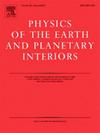极端压力下Fe-P二元化合物的结构、电子和弹性特性:第一性原理计算
IF 1.9
3区 地球科学
Q2 GEOCHEMISTRY & GEOPHYSICS
引用次数: 0
摘要
利用第一性原理计算研究了Fe-P二元化合物在60-360 GPa压力范围内的结构、电子和弹性性能。首先,通过地层焓(∆H)计算和力学稳定性判据,证明FeP和Fe15P不发生相变,在60 ~ 360 GPa压力范围内稳定;值得注意的是,Fe2P和Fe3P发生相变,并且在每个相内都保持稳定。其次,通过Bader电荷和电子定位函数(ELF)证明了Fe15P中P原子和Fe原子之间形成化学键。利用偏态密度(PDOS)和能带结构研究了Fe-P二元化合物的电子性质。此外,发现P元素的存在降低了这些化合物的密度(ρ),使Fe15P和Fe3P更接近初步参考地球模型(PREM)数据。一方面,Fe-P化合物的体积模量(BH)和剪切模量(GH)随压力的增加而增加,但仍低于纯铁;另一方面,Fe3P和Fe15P在135 ~ 360 GPa压力范围内的压缩声速(VP)比纯铁低,更接近PREM数据。Fe-P二元化合物在330 ~ 360 GPa时的剪切声速(VS)也低于纯铁,更接近PREM数据。FeP、Fe2P和Fe3P的泊松比(σ)始终高于纯铁,但与地球内核压力下的PREM数据更接近。最后,Fe3P的ρ、σ、VS和VP均能与PREM数据匹配。因此,Fe-P二元化合物可以作为地核的合适模型,这表明轻元素P可能存在于地核中。本文章由计算机程序翻译,如有差异,请以英文原文为准。

The structural, electronic, and elastic properties of Fe-P binary compounds under extreme pressures: First-principles calculations
The structural, electronic and elastic properties of Fe-P binary compounds under the pressure range of 60–360 GPa are investigated using first-principles calculations. Firstly, based on the calculations of formation enthalpy () and mechanical stability criteria, it is proved that FeP and Fe15P do not undergo phase transition, and they are stable within the pressure range of 60–360 GPa. It is noteworthy that Fe2P and Fe3P suffer phase transition, and they remain stable within each phase. Secondly, the formation of chemical bonds between P and Fe atoms in Fe15P is demonstrated through Bader charge and Electron Localization Function (ELF). The electronic properties of Fe-P binary compounds are examined using Partial Density of States (PDOS) and band structures. Additionally, the presence of P elements is found to reduce the density () of these compounds, bringing Fe15P and Fe3P closer to the Preliminary Reference Earth Model (PREM) data. On the one hand, bulk modulus () and shear modulus () of Fe-P compounds increase with increasing pressure, but remain lower than those of pure iron. On the other hand, the compressional sound velocity () of the Fe3P and Fe15P in the pressure range of 135–360 GPa, which is lower than that of pure iron and closer to the PREM data. Moreover, the shear sound velocity () of the Fe-P binary compounds at 330–360 GPa, which is also lower than that of pure iron and closer to the PREM data. The Poisson's ratio () of FeP, Fe2P and Fe3P is consistently higher than that of pure iron, but aligns more closely with PREM data under pressure of the Earth's inner core. Lastly, the , , and of Fe3P can all match PREM data. Therefore, Fe-P binary compounds may serve as a suitable model for the Earth's core, suggesting that the light elements P could potentially exist within the Earth's core.
求助全文
通过发布文献求助,成功后即可免费获取论文全文。
去求助
来源期刊

Physics of the Earth and Planetary Interiors
地学天文-地球化学与地球物理
CiteScore
5.00
自引率
4.30%
发文量
78
审稿时长
18.5 weeks
期刊介绍:
Launched in 1968 to fill the need for an international journal in the field of planetary physics, geodesy and geophysics, Physics of the Earth and Planetary Interiors has now grown to become important reading matter for all geophysicists. It is the only journal to be entirely devoted to the physical and chemical processes of planetary interiors.
Original research papers, review articles, short communications and book reviews are all published on a regular basis; and from time to time special issues of the journal are devoted to the publication of the proceedings of symposia and congresses which the editors feel will be of particular interest to the reader.
 求助内容:
求助内容: 应助结果提醒方式:
应助结果提醒方式:


